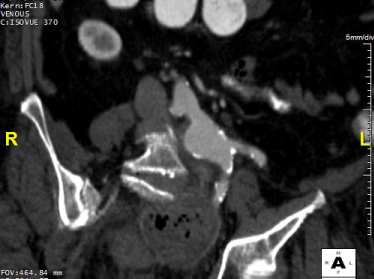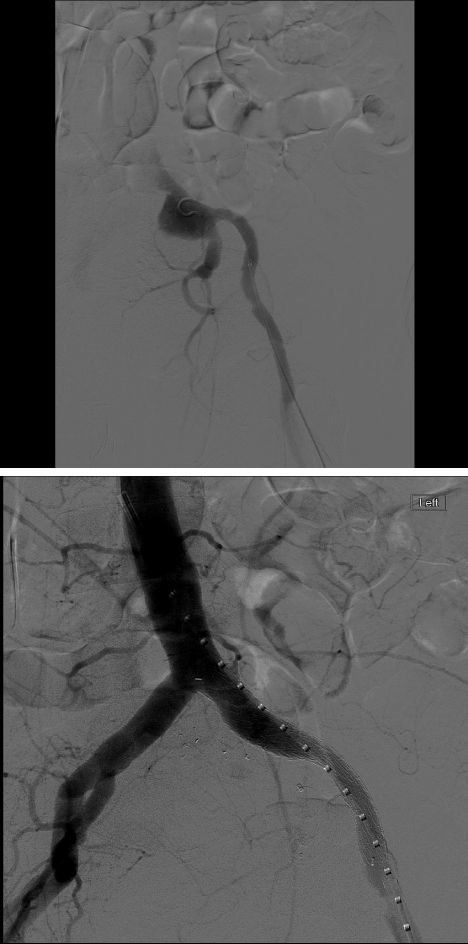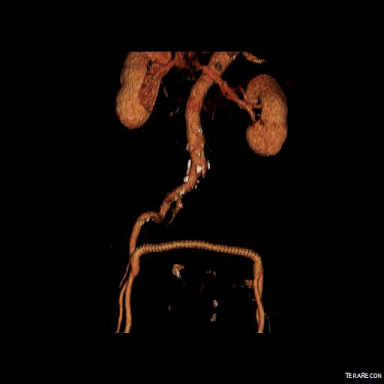Case Report
IStaged Endovascular and open Surgical Management of a Ruptured Common Iliac Artery Aneurysm Presenting with Ilio-Rectal Fistula and Hemorrhagic Shock
Zoe Jones MD, Muhammad Ali A Rana MD*, Mark Langsfeld MD and John Marek MD
Division of Vascular Surgery, University of New Mexico School of Medicine, USA
*Corresponding author: Muhammad Ali A. Rana, Department of Surgery, Division of Vascular Surgery, University of New Mexico School of Medicine, MSC 10 5610 Albuquerque, NM 87131, USA
Published: 14 Oct, 2016
Cite this article as: Jones Z, Rana MAA, Langsfeld
M, Marek J. Staged Endovascular
and Open Surgical Management
of a Ruptured Common Iliac Artery
Aneurysm Presenting with Ilio-Rectal
Fistula and Hemorrhagic Shock. Clin
Surg. 2016; 1: 1156.
Abstract
A wide variety of clinical presentations of complicated iliac arterial aneurysms is documented; however, iliorectal fistula in this setting has not been reported previously. We present a case of an 88-year-old gentleman who presented with massive lower gastrointestinal hemorrhage secondary to rupture of a left common iliac aneurysm with iliorectal fistula. Given the severe shock, patient was treated with endovascular exclusion of the aneurysm achieved with a percutaneous left common to external iliac artery stent-graft and embolization of internal iliac artery. Definitive repair was performed after resuscitation for 72 hours. This included a cross-femoral bypass followed by laparotomy, explantation of stent graft, endoaneurysmorrhaphy, and rectosigmoidectomy with end colostomy. Patient recovered well and over 18 month follow-up has had no complications. In conclusion, primary iliac aneurysms can rarely present with enteric and urological erosions or fistulas resulting in life threatening hemorrhage. Temporizing endovascular therapy despite the contaminated field can be life-saving.
Introduction
Primary Iliac Arterial Aneurysms (IAAs) can rarely present with enteric and urological erosions or fistulas resulting in life threatening hemorrhage. Iliorectal fistula in the setting of a common iliac artery aneurysm (CIAAs) has not been reported previously. Emergent repair of iliac aneurysms is associated with high morbidity and mortality.
Case Presentation
We present a case of an 88-year-old gentleman who presented with massive lower gastrointestinal
hemorrhage secondary to rupture of a left common iliac aneurysm with iliorectal fistula. He was
hypotensive on arrival with lactic acidosis despite ongoing transfusions. Computed tomography
scan (CT) revealed left common iliac artery aneurysm with rupture into the proximal rectum
(iliorectal fistula). Given the severe shock, patient was treated with endovascular exclusion of the
aneurysm achieved with a percutaneous left common to external iliac artery stent-graft (Gore
Excluder Iliac Limb-16mm x 12mm x 10 cm) and embolization of internal iliac artery.
Patient was stabilized and adequately resuscitated over the subsequent 72 hours. Definitive repair
was then performed. This included a extra-anatomical right to left cross-femoral bypass followed
by laparotomy, explantation of stent-graft and embolization plug, endoaneurysmorrhaphy, and
rectosigmoidectomy with end colostomy. There were no peri-operative complications and hospital
stay was 16 days.
Over an 18 month follow-up patient has done well and has had no complications.
Figure 1
Figure 2,3
Figure 2,3
Pre EVAR and post-EVAR arteriograms demonstrating aneurysm and its subsequent exclusion via common to externai iliac stent-graft and embolization of left internal iliac artery.
Figure 4
Figure 4
Follow-up CTA showing final reconstruction (endoanuerysmorrhaphy, exclusion of left iliac system and right-to-left cross femoral bypass).
Discussion
Most IAAs are associated with abdominal aortic aneurysms and isolated common iliac artery
aneurysms (CIAA) are rare. The population incidence of an isolated iliac aneurysm (IAA) is 0.03%
[1], comprising about 2% of all abdominal aneurysms [2]. Etiologies include atherosclerosis, trauma,
mycotic infection, or collagen vascular diseases. Rarely iliac aneurysms can present with mass effect
or erosion into surrounding structures as a result of their indolent expansion [3]. The literature
suggests that all iliac artery aneurysms greater than 3.5cm is repaired [4].
Up to 50% of these aneurysms can be symptomatic [2] and emergent repair in this setting carries
up to 27% mortality in contemporary literature [4]. Iliorectal fistulas
have been reported secondary to internal iliac aneurysmal erosion
[3], however, common iliac aneurysm with ileorectal fistula has not
been described in the literature.
Our patient proved to be a diagnostic challenge. Lower
gastrointestinal endoscopy was inconclusive and non-enhanced
CT guided drainage of suspected abscess revealed arterial blood. A
subsequent CT arteriogram confirmed the diagnosis [5].
Although in a contaminated field endovascular treatment using a
prosthetic stent-graft is traditionally contra-indicated, it proved to be
life-saving in the setting of life threatening hemorrhage. This was later
converted to an aseptic extra-anatomical vascular reconstruction
along with required fecal diversion once the patient was stabilized.
Conclusion
Primary iliac aneurysms can rarely present with enteric and urological erosions or fistulas resulting in life threatening hemorrhage. Temporizing endovascular therapy despite the contaminated field can be life-saving.
References
- Brunkwall J, Hauksson H, Bengtsson H, Bergqvist D, Takolander R, Bergentz SE. et al. Solitary aneurysms of the iliac arterial system: an estimate of their frequency of occurrence. J Vasc Surg. 1989; 10: 381-384.
- Chaer RA, Barbato JE, Lin SC, Zenati M, Kent KC, McKinsey JF. Isolated iliac artery aneurysms: A contemporary comparison of endovascular and open repair. J Vasc Surg. 2008; 47: 708-713.
- Goto A, Yu I, Naito T, Yabana T, Adachi T, Kondo Y. et al. Fistula from the internal iliac artery aneurysm to the sigmoid colon after endovascular arterial repair. Endoscopy. 2014; 46: E367-E368.
- Huang Y, Gloviczki P, Duncan AA, Kalra M, Hoskin TL, Oderich GS, et al. Common iliac artery aneurysm: expansion rate and results of open surgical and endovascular repair. J Vasc Surg. 2008; 47: 1203-1210.
- Sandhu RS, Pipinos II. Isolated iliac artery aneurysms. SeminVasc Surg. 2005; 18: 209-215.



